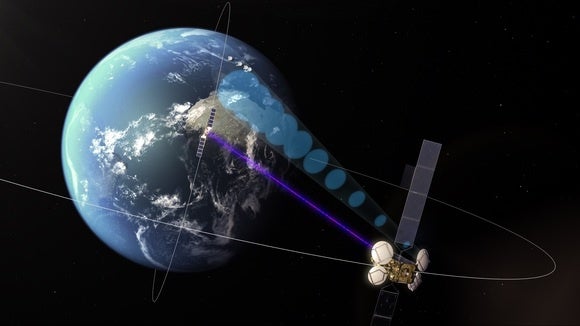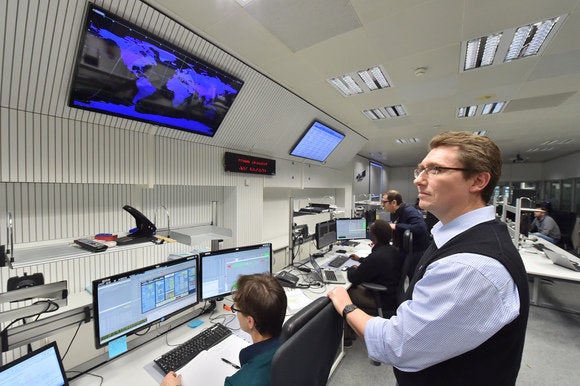
Credit: Airbus Space and Defense
The satellite’s main role will be downlinking hundreds of TV channels to viewers in Europe, but it will also carry the first node in the European Space Agency’s European Data Relay System (EDRS).
EDRS is an attempt to provide a high-speed interconnect between satellites. If it works, scientists will be able to gather data from low-orbiting satellites much more quickly than they can today.
The data incurs delays today because the satellites fly relatively close to earth so they can collect the images and measurements that scientists need.
This low orbit (400 to 800 kilometers) means they’re only in range of their ground stations for about 10 minutes during a 90-minute orbit, so the data has to be stored on board until it can be delivered.
EDRS sends the data to a satellite in geostationary orbit, roughly 36,000 kilometers above earth. From that higher perch, the geostationary satellite can stay in contact with the scientific satellite for much of its orbit, and be in constant contact with a ground station.
“We want [images] as fast as possible, and as many of them as possible, and in the best quality we can have,” said Michael Witting, the EDRS project manager, during a briefing earlier this month.
 EUROPEAN SPACE AGENCY
EUROPEAN SPACE AGENCYNASA uses a similar arrangement to stay in touch with the International Space Station, which is also in a low-Earth orbit. But NASA’s Tracking and Data Relay Satellite (TRDS) fleet uses radio communications. EDRS uses a laser to send the data up to the geostationary satellite.
The European Space Agency likens the system to a highly accurate telescope, because the upper satellite has to lock onto a laser beam coming from a moving satellite 45,000 kilometers below. It requires great precision, but the ESA is confident it could work at even greater distances.
“From the testing we’ve done, we know it can operate up to 75,000km,” Witting said.
The lasers carry the data at up to 1.8Gbits per second. The signal is sent back to Earth from Eutelsat 9B on a ka-band radio link. When fully deployed, the EDRS system will carry roughly 50 terabytes of data per day from space back to earth, according to European Space Agency estimates.
The system is expected to first be used this summer when EDRS relays signals from theEuropean Commission’s Copernicus Sentinel-1 and -2 satellites. They’re tasked with high-resolution radar and optical imaging of land and sea, including for emergency services.
The EDRS system on Eutelsat 9B will be operated by Airbus Space and Defense as a commercial service. A second satellite dedicated to EDRS is scheduled to be launched in 2017.
The system was tested successfully in 2014 when the Sentinel-1 satellite sent an image back to earth via Inmarsat’s Alphasat. The latter satellite carried an older laser communications terminal, and the transmission was intended to prove the system could work.
 J MAI/ESA
J MAI/ESA[“source -cncb”]




